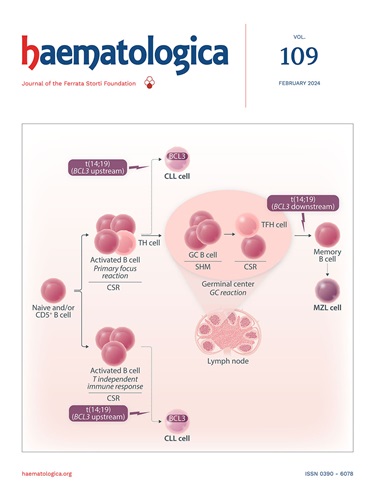肿瘤体积在常见淋巴瘤亚型现代治疗中的预后价值:一项澳大利亚淋巴瘤及相关疾病登记研究。
IF 7.9
1区 医学
Q1 HEMATOLOGY
引用次数: 0
摘要
在淋巴瘤中,单个大的疾病部位或所谓的肿瘤“大块”的存在与预后有不同的相关性,并影响管理决策。然而,由于不同淋巴瘤亚型的定义不同,而且在每种亚型的研究中,正电子发射断层扫描(PET)在决策中的应用增加,以及最近新疗法的结合,将体积作为预后指标出现了挑战。我们分析了来自澳大利亚淋巴瘤登记处的数据,分析了六种关键亚型:弥漫性大b细胞淋巴瘤(DLBCL)、滤泡性淋巴瘤、边缘区淋巴瘤、t细胞淋巴瘤、霍奇金淋巴瘤(HL)和伯基特淋巴瘤(BL)的存在及其对预后和治疗决策的影响。在2016-2025年间确定的5090名符合条件的患者中,88%的患者有关于肿块存在的记录信息(注册定义为bbb50 cm)。与没有肿块的患者相比,有肿块的患者更可能单独接受全身化疗,而不太可能单独接受局部治疗(放疗和/或手术)。在单变量分析中,体积与DLBCL患者较低的总生存期(OS)和HL患者较高的总生存期(OS)相关。使用来自澳大利亚和新西兰执业临床医生的疾病特异性体积定义的探索性分析显示,DLBCL(体积>为7.5cm)和BL患者(体积>为10cm)的无进展生存期较差,但其他亚型没有。我们展示了现实世界的证据,证明了大体积患者的治疗异质性,具有潜在的预后意义。为了在临床研究中统一应用pet为基础的和分子预测,需要对体积的定义进行国际标准化。澳大利亚新西兰临床试验注册中心的试验注册:ANZCTRN12617000050358。本文章由计算机程序翻译,如有差异,请以英文原文为准。
Prognostic value of tumor bulk in modern management of common lymphoma subtypes: an Australasian Lymphoma and Related Diseases Registry study.
The presence of a single large disease site or so-called tumor 'bulk' in lymphoma has been variably associated with outcomes and influenced management decisions. However, challenges arise in using bulk as a prognosticator due to varied definitions across different lymphoma subtypes but also within studies of each subtype, increased utility of positron emission tomography (PET) in decisionmaking and recent incorporation of novel therapies. We analyzed data from the Australasian Lymphoma Registry regarding presence and influence of bulk on outcomes and treatment decisions in six key subtypes: diffuse large B-cell (DLBCL), follicular, marginal zone, T-cell, Hodgkin (HL) and Burkitt lymphoma (BL). Of the 5090 eligible patients identified between 2016-2025, 88% had documented information on the presence of bulk (registry definition >5cm). Patients with bulk were more likely to receive systemic chemotherapy alone, and less likely to have localized treatment alone (radiotherapy and/or surgery), compared to those without bulk. Bulk was associated with inferior overall survival (OS) in DLBCL patients, and superior OS in HL patients, in the univariate analyses. Exploratory analysis using disease-specific bulk definitions from clinicians practising in Australia and New Zealand showed inferior progression-free survival in DLBCL (bulk >7.5cm) and OS in BL patients (bulk >10cm), but not other subtypes. We demonstrated real-world evidence of management heterogeneity for patients with bulk, with potential prognostic implications. International standardization of the definition of bulk is urged for uniform utility in PET-based and molecular prognostication across clinical studies. Trial registration at the Australian New Zealand Clinical Trials Registry: ANZCTRN12617000050358.
求助全文
通过发布文献求助,成功后即可免费获取论文全文。
去求助
来源期刊

Haematologica
医学-血液学
CiteScore
14.10
自引率
2.00%
发文量
349
审稿时长
3-6 weeks
期刊介绍:
Haematologica is a journal that publishes articles within the broad field of hematology. It reports on novel findings in basic, clinical, and translational research.
Scope:
The scope of the journal includes reporting novel research results that:
Have a significant impact on understanding normal hematology or the development of hematological diseases.
Are likely to bring important changes to the diagnosis or treatment of hematological diseases.
 求助内容:
求助内容: 应助结果提醒方式:
应助结果提醒方式:


